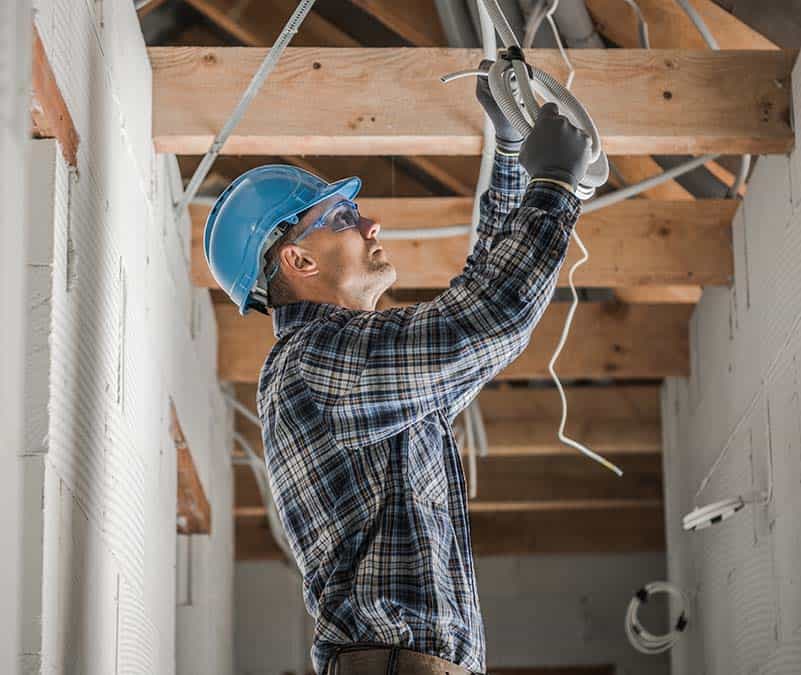Residential Electrical Installation: Step-by-Step Procedure

As electricians in San Antonio, TX we are regularly tasked with building residential electrical installations in new constructions (both homes and multi-family units). Any new installation is broken down in several phases aiming at ensuring that the electrical system is safe, efficient, meets the needs of a family, and is 100% compliant with all applicable local codes and federal regulations.
For the benefit of people interested in building a new home and understanding what are the phases of an electrical installation, we broke down our procedure step-by-step and summarized it here.
Important note: Although a homeowner could take this list and follow the progress made by their own electrical contractor on their own installation, in reality this procedure reflects our own work schedule and best practices. Other licensed professional electricians evolve their own procedures, and it is advisable for the homeowner to obtain the applicable documentation from their electrical contractor. In addition we omitted certain proprietary steps from this list, and we update our own procedure regularly. We communicate this document for informational and educational purposes only.
1. Residential Electrical Installation: Planning & Design
Before the first cable is run into a new home, the electrical installation will be fully planned out and vetted by the General Contractor, the State, the county and the city. The first phase is a phase of planning and designing the installation according to the blueprints provided by the GC, and other details provided by the homeowners.
The design process starts with the load calculation. Load calculation is like checking if your home’s electrical “backpack” can safely carry all your gadgets and lights.
A. Load Calculation
Procedure
- Listing all electrical devices: We begin by listing all the electrical devices, appliances, and fixtures that will be used in the home. This includes everything from lighting fixtures to large appliances like refrigerators and HVAC systems. That’s where the homeowners’ information comes handy. The GC will already have a list to work from.
- Determining individual loads: For each device, we determine its power rating, usually given in watts or amperes. This information can typically be found on the devices’ label or in their owner’s manual.
- Summing the total load: We add up the power requirements of all devices to get the total electrical load for the house.
- Factoring in future needs: We need to account for potential future electrical needs, so as a common practice we add a margin (e.g., 20%) to the calculated total load.
Deliverables
- Load calculation sheet: We provide the homeowner and the GC with a detailed document that lists all devices, their power ratings, and the total calculated load for the home.
- Future expansion recommendations: We make suggestions for potential future electrical needs.
B. Designing the circuits
Procedure
- Grouping devices: We group devices based on their location and function. For instance, we may group all kitchen appliances together, and group lighting fixtures by room.
- Determining circuit loads: For each group, we calculate the combined load to determine how many circuits are needed and how the load will be distributed among them.
- Designing circuit paths: We plan the route each circuit will take from the main panel to each device it powers. This is to ensure the shortest and most efficient path.
- Safety and redundancy: Ensure that no circuit is overloaded and that there’s redundancy, meaning critical appliances might have dedicated circuits.
Deliverables
- Blueprint of the circuit design: A detailed schematic showing the layout of all circuits, their paths, and the devices they power.
- Circuit load sheet: A document detailing the load on each circuit.
C. Selecting materials & supplies
Procedure
- Choosing wire types and sizes: Based on the load calculations and circuit design, we select the appropriate wire type (e.g., copper or aluminum) and size (gauge) for each circuit.
- Selecting circuit breakers: We choose the circuit breakers that match the load of each circuit and provide the necessary protection.
- Picking outlets and switches: We decide on the type (e.g., standard, GFCI, dimmer) and style of outlets and switches for each room.
- Other materials: We select other necessary supplies like conduit, junction boxes, and light fixtures.
Deliverables
- Materials list: We provide the GC and the homeowners a comprehensive list of all materials selected, including type, size, quantity, and specifications.
- Cost estimate: We present an estimated cost for all the materials based on current market prices.
D. Safety considerations
Procedure
- Identifying wet and hazardous areas: We pinpoint areas like bathrooms, kitchens, and outdoor spaces where there’s a higher risk of water contact.
- Planning for GFCIs: In the identified wet areas, we plan for the installation of Ground Fault Circuit Interrupters to prevent electrocution.
- Planning for AFCIs: In bedrooms and other living spaces, we plan for the installation of Arc Fault Circuit Interrupters to prevent electrical fires.
- Ensuring proper grounding: We design a grounding system to ensure that any stray currents are safely directed to the earth, preventing electrical shocks.
Deliverables
- Safety plan: We provide the document detailing all safety measures to be implemented, including the location of GFCIs, AFCIs, and grounding points.
- Grounding blueprint: We also provide the schematic showing the design of the grounding system, including grounding rods and connections.
This completes Phase I: Planning & Design. The next phase is the Rough-in.
2. Residential electrical installation: Rough-In phase
Each of these steps in the rough-in phase ensures that the foundational elements of the electrical system are correctly and safely put in place, ready for device installation and connections.
A. Conduit Installation
Procedure
- Map out routes: Based on the circuit design, we determine the best paths for conduits inside walls, ceilings, and floors.
- Choose conduit type: We then decide on the type of conduit (e.g., PVC, metal) suitable for the environment and local codes.
- Install conduit: We drill the holes, attach conduit to framing, and ensure it runs seamlessly from the main panel to each electrical box.
Deliverables
- Conduit installation map: A visual representation showing where all conduits are placed within the home.
- Materials & length report: A list detailing the types and lengths of conduits used.
B. Box Installation
Procedure
- Determining box types: We choose the appropriate box types (e.g., single-gang, double-gang) based on the number of devices they house.
- Marking locations: Based on the circuit design, we mark where each box will be installed on walls, ceilings, or floors.
- Securing boxes: We attach electrical boxes to studs, joists, or masonry using appropriate fasteners, ensuring they’re flush with the finished wall or ceiling surface.
Deliverables
- Box placement blueprint: A detailed layout showing the location of each electrical box in the home.
- Box type & count list: A document listing the types and quantities of boxes installed.
C. Wire Pulling
Procedure
- Measure & cut wires: Based on the circuit design, we measure and cut the required lengths of wire.
- Feed wires: We run wires through the conduits, starting from the main panel and extending to each electrical box.
- Label wires: We clearly label wires at both ends to identify their purpose (e.g., “kitchen lights” or “living room outlet”).
- Leave extra length: We ensure there is extra wire length at each box for trimming and connections later.
Deliverables
- Wiring map: We present a schematic detailing the path of each wire from the main panel to its endpoint.
- Wire length & type report: This list details the types, colors, and lengths of wires used in the installation.
3. Electrical Installation: Inspection
Before proceeding to the next phase, a preliminary inspection is usually required.
An electrical inspector checks the wiring, ensuring it’s up to code, properly secured, and that the right type and size of wire are used for each circuit.
4. Device installation
At this point, we will install all outlets and fixtures.
- Outlets and switches: We trim the wires to the appropriate length and connect them to outlets and switches.
- Light fixtures: We install the ceiling and wall light fixtures, and connect them to the wiring.
- Circuit breakers: We install the circuit breakers in the main panel and connect the circuits to them.
5. Main Panel Connection
The next step is to connect the main panel. This phase ensures that the home electrical system is safely connected to the grid, ready to distribute power throughout the residence.
A. Service Entry
Procedure
- Determining the entry point: We work with the utility company to identify the best location for the electrical service to enter the home.
- Installing the service conduit: We set up a conduit from the entry point to the main panel, ensuring it meets local code requirements for depth and protection.
- Pulling service wires: We run the main service wires (two hot wires and one neutral) through the conduit into the main panel.
Deliverables
- Service entry blueprint: A diagram showing the location and path of the service entry from the utility pole or underground service to the main panel.
- Service specifications: A document detailing the type, size, and rating of the service wires and conduit used.
B. Meter Installation
Procedure
- Selecting the meter location: We pick a location that is easily accessible for meter reading and maintenance, outside the home.
- Installing the meter base: We secure the meter base (the box that houses the meter) to the exterior wall, ensuring it is level and at the correct height.
- Connecting the service wires: We attach the incoming service wires to the meter base, ensuring proper connections to measure electricity usage.
- Involving the utility company: The utility company will typically install the actual meter once everything is set up.
Deliverables
- Meter installation diagram: We create a visual representation showing the location and setup of the meter base and its connection to the service entry.
- Connection report: We give the client and the GC a document detailing the connections made within the meter base and any specifications provided by the utility company.
C. Main Breaker
Procedure
- Choosing the breaker size: Based on the load calculation, we select an appropriately rated main breaker to handle the home’s total electrical demand.
- Installing the main breaker: We secure the main breaker within the main panel. It must be positioned in such a way it is easy for the homeowners to cut off power to the entire house.
- Connecting the service wires: We attach the incoming service wires to the main breaker. Connections must be tight and secure.
- Grounding: We connect the grounding wire from the main breaker to the home grounding system to ensure safety.
Deliverables
- Main breaker installation guide: This is a detailed document showing the installation process, location, and setup of the main breaker within the panel.
- Connection & grounding report: This is our report detailing the connections made to the main breaker and the grounding setup.
6. Residential electrical installation: Testing & verification phase
Each of the steps of the Testing & Verification Phase helps to ensure that the electrical installation is safe, efficient, and ready for use. These tests are designed to catch and correct any issues before the system is energized, reducing the risk of electrical fires, shocks, or equipment damage.
A. Continuity Check
Procedure
- Testing wires & circuits: We use a continuity tester or multimeter to ensure that electrical current can flow through each wire and circuit without interruption.
- Identifying and fixing issues: If we detect a break in continuity, we identify the location of the issue and repair the wire or connection as needed.
Deliverables
- Continuity Report: A document detailing the results of the continuity tests for each circuit, noting any issues found and the repairs made.
B. Polarity check
Procedure
- Testing outlets & connections: We use a polarity tester to ensure that all outlets and connections are wired correctly, with hot and neutral wires in their proper places.
- Correcting wiring issues: If we detect an incorrect polarity, we rewire the connections to ensure proper orientation.
Deliverables
- Polarity Test Report: It’s a short document detailing the results of the polarity tests for each outlet and connection, noting any issues found and the corrections made.
C. Voltage test
Procedure
- Measuring voltage levels: Using a multimeter we measure the voltage at various points in the system, to ensure it falls within the expected range.
- Adjustments: If voltage levels are found to be outside the acceptable range, adjustments may need to be made at the main panel or at individual circuit breakers.
Deliverables
- Voltage test report: This document details the voltage levels we measured throughout the electrical system, and shows any discrepancies and the adjustments made.
D. Grounding test
Procedure
- Inspecting the grounding system: By visually inspecting the grounding system, we ensure all components are securely connected and free of corrosion.
- Measuring ground resistance: Using a ground resistance tester, we measure the resistance of the grounding connection of the electrical system to the earth.
- Improvements: If we find the grounding system is inadequate, we may install additional grounding rods, or clean and tighten existing connections.
Deliverables
- Grounding inspection report: This is a document detailing the visual inspection and the resistance measurements of the grounding system. It shows any issues found and the improvements we made.
The final steps of the electrical installation ensure it is not only complete and functional, but also documented and understood by the homeowner using proper documentation adjoined to a successful final safety inspection.
7. Residential electrical installation: Final Inspection
Procedure
- Requesting the inspection: Once we complete the electrical installation, we request a final inspection from the San Antonio building department.
- Walkthrough with the inspector: The electrical inspector conducts a thorough examination of the entire electrical system, checking for code compliance, safety, and proper installation.
- Addressing any issues: If the inspector identifies any issues, they must be addressed and corrected before the system can be approved.
Deliverables
- Inspection report: The inspector will create a report detailing the results of the final inspection, noting any issues found and their resolution.
- Approval certificate: Once we have addressed all remaining issues and the system passes inspection, the inspector issues a certificate of approval or occupancy, indicating the electrical system is safe for use.
8. Commissioning
Procedure
- Powering up: We energize the main panel by turning on the main breaker to supply power to the entire home.
- Testing devices & fixtures: We turn on and test all electrical devices, fixtures, and appliances to ensure they operate correctly.
- Checking for issues: We monitor for any unusual sounds, smells, or behaviors that might indicate a problem.
Deliverables
- Commissioning report: This document details the results of the commissioning process, noting the performance of each device, fixture, and appliance, and any issues encountered.
- Recommendations: If any issues arise or improvements are suggested during commissioning, they’ll be listed in a recommendations section for future reference.
9. Documentation of the residential electrical installation
Procedure
- Compiling installation details: We gather all details, blueprints, schematics, and reports related to the electrical installation.
- Creating a user manual: We develop a homeowner-friendly guide that explains the home’s electrical system, including the location of the main panel, circuit breakers, and key devices.
- Providing maintenance recommendations: Offer guidelines on routine maintenance, safety precautions, and potential upgrade suggestions.
Deliverables
- Electrical system documentation: We provide a comprehensive binder or digital file containing all details, diagrams, and reports related to the electrical installation.
- Homeowner’s electrical manual: This is a user-friendly guide explaining the electrical system’s operation, maintenance, and safety tips.
This completes the step–by-step procedure of a typical residential electrical installation. As licensed professional electricians in San Antonio, TX we comply at all times with city, county and state code and ordinances. We did not mention here all the compliance details, but every step of the way would be completed per application regulations.
This electrical installation procedure can be modified to dovetail into the larger context of a general contractor’s time frame and building plan. Anyone familiar with the construction business knows that nothing happens in a linear manner. However, all steps of the electrical installation procedure will have to be completed.
Selecting All Star Electric for your residential electrical installation
All Star Electric has been operating as licensed residential electricians and commercial electrical contractors in San Antonio since 1995, almost 30 years ago. Our business is accredited with the BBB San Antonio and has kept its A+ rating with excellent quality service. We are a member of the San Antonio Chamber of Commerce since 2016. We design, engineer and install all types of electrical systems for homes and businesses in San Antonio and neighbording cities in Bexar County.
Even if the mission is to install low-voltage systems, creating a residential electrical installation is not a hobby. It must be the work of a licensed professional electrician who will apply all their knowledge to ensure that the installation is safe, that it operates within specifications, and that it is compliant with all local codes and federal regulations.
If you think of installing any type of electrical system in your home, consult with us. Call us, and we will come to your residence to study your project, advise you, and give you an estimate.




























